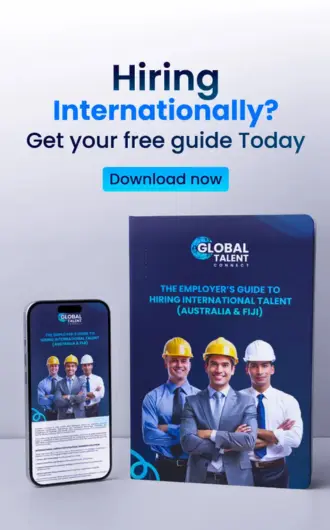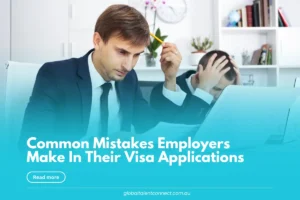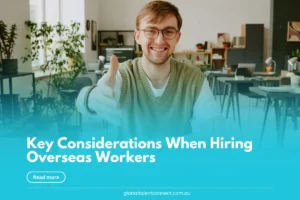Hiring skilled workers from overseas can help fill gaps and grow your business, but even small errors in the Australian visa process can cause major delays or refusals. Common pitfalls include missing documents, overlooking health or character checks, or not meeting sponsorship obligations.
Often, these mistakes happen because employers lack clear processes or aren’t up to date with visa rules. The good news? Most issues are preventable with careful planning.
In this article, we highlight the top mistakes employers make when sponsoring overseas workers, and how to avoid them – so you can secure a smoother, faster visa outcome.
Most Common Mistakes Employers Make
1. Incomplete or Incorrect Documentation
This is one of the biggest and most common reasons sponsorship applications face delays or rejections. Missing or incorrect information can easily derail the entire process.
Common issues:
- Outdated or missing documents
- Errors in the employee’s work history or qualifications
- Incorrect or inconsistent financial records
- Mismatched details between the sponsorship, nomination, and visa applications
How to avoid it:
- Use a checklist to make sure everything is included.
- Cross-check details across all applications.
- Ensure translations are accurate and certified.
- Get an immigration lawyer or migration agent to review before submission.
Spending a little more time up front can save months later.
2. Misunderstanding Visa Eligibility Requirements
Many applications run into trouble because employers don’t fully understand eligibility rules. Requirements are detailed and can often change.
For the Skills in Demand Visa, it’s not just about offering a job; the occupation, salary, and worker’s qualifications must meet Department of Home Affairs (2025) standards.
Common mistakes:
- Choosing the wrong occupation code
- Offering salaries below TSMIT ($73,150 or market rate)
- Overlooking English, health, or character checks
- Using outdated information
How to avoid it:
- Review current eligibility criteria.
- Match job descriptions with the correct occupation code.
- Offer salaries that meet or exceed required thresholds (e.g. $135,000 for Specialist Pathway).
- Complete Labour Market Testing (LMT) correctly if required.
- Check for recent updates before lodging.
3. Labour Market Testing (LMT) Missteps
Before nominating an overseas worker, employers must prove they’ve tried to hire locally. This Labour Market Testing (LMT) is required for many employer-sponsored visas, including the Skills in Demand Visa (Subclass 482).
Common mistakes:
- Advertising for less than 28 consecutive days
- Posting on non-approved platforms
- Failing to keep evidence
How to avoid:
- Advertise on JobActive and at least two job boards like Seek or Global Talent Connect.
- Keep the ad live for 28 consecutive days.
- Save screenshots, links, and all supporting records.
Failing to meet LMT is a leading cause of refusals, but also one of the easiest to prevent.
4. Sponsorship Compliance Errors
Your responsibilities don’t end once the visa is approved. Employers must stay compliant throughout the sponsorship period.
Key obligations:
- Notify the Department of Home Affairs about changes to the employee’s role, salary, or conditions
- Keep accurate and up-to-date records
- Ensure the employee works only in the approved role
Non-compliance can lead to visa cancellation, sponsorship suspension, or legal penalties.
How to avoid it:
- Know your legal obligations.
- Set up a clear internal compliance process.
- Schedule regular check-ins with a migration advisor or legal professional.
5. Choosing the Wrong Occupation Code
Every application must include an occupation from the Core Skills Occupation List (CSOL). Picking the wrong one can cause delays or even lead to refusals. Sometimes employers choose a “close enough” occupation to fit the rules. This can result in compliance issues later.
How to avoid it:
- Review the CSOL carefully to choose the occupation that best matches the employee’s actual duties.
- Don’t take shortcuts.
- Get migration advice if unsure.
6. Missing Deadlines and Time Frames
The visa process involves multiple deadlines. Missing one can slow everything down or lead to rejection.
Common timing errors:
- Submitting applications too late
- Not planning for LMT periods
- Missing follow-up deadlines
How to avoid it:
- Map out the timeline early.
- Assign someone to track key dates.
- Build in buffer time for delays or document requests.
Treat the process like a project with clear milestones to keep things on track.
7. Lack of Communication with Employees
Miscommunication between employers and sponsored employees can cause delays. Confusion over required documents, deadlines, or job details can create unnecessary issues.
How to avoid it:
- Share a clear document checklist early.
- Explain deadlines and why accuracy matters.
- Do a quick pre-submission review.
- Offer extra support if the employee is overseas.
A few clear conversations can save weeks of back-and-forth later.
8. Relying Solely on Assumptions Instead of Guidance
Migration rules change often. Relying on old information or guesswork is a big risk.
Common issues:
- Using outdated salary thresholds or occupation codes
- Assuming exemptions without checking current rules
- Missing key policy changes (e.g. the 2024 shift from TSS to Skills in Demand Visa)
How to avoid it:
- Always check the Department of Home Affairs website for updates.
- Subscribe to migration alerts.
- Consult a migration lawyer if unsure.

When to Seek Professional Help
While some employers handle applications internally, professional support can save time and stress.
Migration lawyers and agents can:
- Spot errors early and help avoid delays
- Ensure your application is legally compliant
- Keep you on track with sponsorship obligations
- Stay up to date with policy changes
For businesses sponsoring multiple employees, expert support can make the process smoother and more reliable.
Conclusion & Key Takeaways
Sponsoring overseas talent can give your business the skills it needs to grow, but the process must be managed carefully. Most mistakes that cause delays or refusals are preventable with good planning, clear communication, and the right support. Global Talent Connect can guide you through every step of the sponsorship process. Download The Employer Guide to Hire International Talent or speak to a migration specialist to get started.




